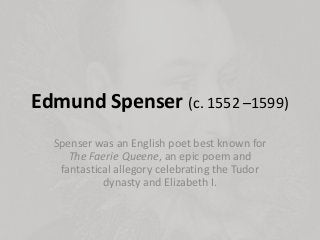
Edmund spenser the renaissance
- 1. Edmund Spenser (c. 1552 –1599) Spenser was an English poet best known for The Faerie Queene, an epic poem and fantastical allegory celebrating the Tudor dynasty and Elizabeth I.
- 2. Edmund Spenser (c.1552-1599) Edmund Spenser used another variation with a rhyme scheme a b a b b c b c c d c d e e Although the rhyme scheme does not indicate it, both he and Shakespeare often used the convention of the volta or shift in thought at the end of the eighth line in order to heighten dramatic emphasis. They were also fond of using the couplet, or last two lines, to clinch or sum up the argument or theme of their poems.
- 3. Edmund Spenser (c. 1552 –1599) One day I wrote her name upon the strand, But came the waves and washed it away: Again I wrote it with a second hand, But came the tide, and made my pains his prey. ‘Vain man,’ said she, ‘that dost in vain assay, A mortal thing so to immortalize For I myself shall like to this decay, And eek my name be wiped out likewise.’ ‘Not so,’ quod I ‘let baser things devise To die in dust, but you shall live by fame: My verse your virtues rare shall eternize, And in the heavens write your glorious name: Where whenas death shall all the world subdue, Our love shall live, and later life renew.’ One Day I Wrote Her Name Upon the Strand